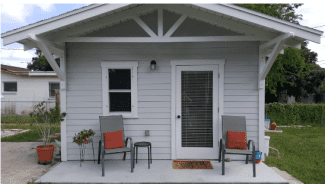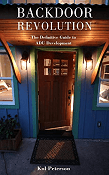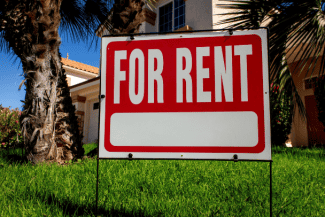4 Reasons for Investors to Add an Accessory Dwelling Unit
By Koi Peterson author of Backdoor Revolution- The Definitive Guide to ADU Development

An accessory dwelling unit, ADU for short, is a secondary dwelling unit with a kitchen, bathroom, sleeping, and living space on the same tax lot as a primary residential dwelling. The ADU can be detached, above a garage, attached, or within the primary unit. Basement and garage conversions are great examples of bonus spaces that can instead be converted into income-generating ADUs.
Cities all over the country are experiencing a shortage of housing, driving up housing costs for both the rental and ownership markets. Cities rely on property owners and developers to develop the much-needed infill housing. Many cities, especially on the west coast, are reducing barriers to develop ADUs, creating new opportunities for investors that own single family homes and duplexes, to build them.
For investors who prefer the long game, ADUs have an excellent track record of providing reliable income and lifestyle flexibility. Here are four reasons why.
1. Versatility
Very few homes have the versatility of an ADU. Unlike primary homes that are typically 3-4 bedrooms, ADUs are typically studio or 1-bedroom units. This is attractive to 1-2 person households who wish to live in residential neighborhoods rather than a commercial apartment complex.
Multigenerational household living is on the rise in both the rental and ownership markets due to housing costs. The need for adaptable 1-story infill housing units that works for different age demographics, has never been more evident.
An ADU can provide for common household needs, such as guest quarters, home office, housing for in-laws or friends in transition, or possibly as a short-term rental. Many small-scale investors start out by adding an ADU to their primary residence and renting it out.
Financially savvier even still, an investor may move into the ADU and rent out the primary residence, potentially covering the full cost of the mortgage for the property. This particular “house hack” is a life-changing financial move for many young property owners, setting them on the course of financial freedom and the wealth production that can come with property ownership.
2. Increased property value
Building an ADU is no small task. Design, permitting, and construction costs add up. However, over time, the ADU will pay for itself, some in as little as 3-5 years, depending on the type of ADU that is developed.
ADUs have more advantages than disadvantages once they’re built and performing, especially in urban infill neighborhoods, where walkability to amenities is plentiful, and renters typically pay higher rents. ADUs tend to make the most financial sense to develop on more expensive infill properties where the land values are highest since they are being developed on ‘free dirt’ you already own. Other rental housing development requires land acquisition, and that dirt is typically the most expensive part of housing development.
Consistent rental income, and two livable units are a great combination for buyers, and they are willing to pay higher prices for a home that can meet various lifestyle needs over the course of ownership. Hiring a real estate agent that understands the value of ADUs is crucial, more and more real estate agents are tuning in to the ADU trend and stand ready to help. https://www.aduspecialist.org/registry
3. More affordable than buying a new rental property
Building an ADU can be an excellent alternative to purchasing another investment property, particularly in high-priced markets where a deal is hard to find. While a newly built ADU can cost upwards of $300k in some markets, a duplex in the same market might start in the $700k’s and require 20% down to purchase. The rents in the duplex may not be at market rate and legislation may impact the rate in which those rates can be increased. A newly developed unit on a property already in a portfolio can fetch market rate upon completion, a strong case for building new.
Living in the ADU and renting out the primary dwelling offers the opportunity to to receive a higher monthly rent, creating a pathway to paying down mortgage and construction costs at a faster rate. If the jurisdiction allows for both the ADU and the primary dwelling to be rented out, as is the case on the west coast, the return on investment is likely to be high.
4. Making an impact
Rental portfolios have social and environmental impacts.
In its Making Room: Housing for a Changing America exhibit, AARP illustrated the type of housing that currently exists compared to the household sizes that are most common in the United States. There is a great disparity between the number of smaller households and the appropriate size homes. Cities desperately need more ‘right-sized’ housing units to serve smaller households, and investors have an opportunity to create housing that is in high demand with a strong tenant base.
Building an ADU can also provide jobs and support the local economy. Hiring local architects, designers, builders, and tradespeople supports the local economy with jobs and housing.
Care to make an ecological impact? Residential buildings comprise 22% of the greenhouse gas emissions in the United States. An 800 sq ft ADU built to basic code uses less energy than a 2,200 sq ft high performance house, due to the reduced heating and cooling loads. Building small saves occupants money in utility bills, making the dwelling more resilient and reliable. Smaller dwellings, and especially internal conversions, use fewer material resources and can rely on the original dwelling to provide part of or all of the building envelope, one of the most resource intensive aspects of a new build.
If you’re interested in learn more about adding an ADU to your portfolio, consider attending an All About ADUs class in your market. Or, you can learn more about ADUs in Koi Peterson’s book, Backdoor Revolution- The Definitive Guide to ADU Development.
About the Author:

















 Accessibility
Accessibility